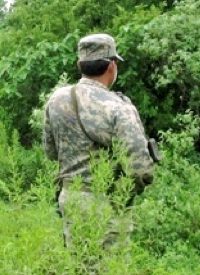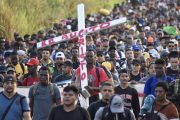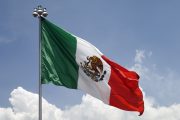
The drug turf wars claimed another victim on August 18 in the Mexican state of Nuevo Leon. Reuters reported security forces found the slain body of 38-year-old Edelmiro Cavazos near Monterrey, Mexico’s richest city, dumped on a rural road outside his town of Santiago.
On August 19, as mourners attended the funeral service for Cavazos, Fox news reported that six police were arrested for the killing, including the officer who guarded the Santiago house from which Cavazos was seized the previous Sunday. Cavazos had been shot three times, was blindfolded and his hands were tied. The death of Cavazos, the U.S. educated father of three, marked the first attack on an official by cartels in Nuevo Leon.
The six confessed to being involved in the killing of Cavazos, according to Nuevo Leon state Attorney General Alejandro Garza y Garza. He said additional suspects are being pursued, and accused drug cartels of being responsible for the killing. In Monterrey, drug violence has surged this year since a dispute between the powerful Gulf cartel and its former armed wing the Zetas turned into all-out war. The state’s Governor, Rodrigo Medina, said Cavazos was probably targeted for his efforts to clean up Santiago’s corrupt police force, part of a nationwide effort to stop police graft. Mayor Mauricio Fernandez of Monterrey’s wealthy San Pedro Garza Garcia municipality told local radio, “When the mayor took office, he told me that criminal groups had gone to see him, saying: either you join us or we eliminate you.”
Fox reported that Cavazos had sought advice on how to handle the threats but officials at the state AG’s office said they hadn’t been informed of the threats. General Guillermo Moreno, commander of troops in Nuevo Leon and the neighbor sate of Tamaulipas said the army hadn’t received notice of threats from the mayor nor requests for protection. (Read: “Who’s Winning Mexico’s Drug War?“)
Nuevo Leon’s northernmost boundary is shared with Texas, as is that of Tamaulipas. The Mexican extension of what is U.S. I-35 (path of the continental NAFTA Superhighway) passes through both states, and is an important drug traffic corridor. Santiago, a town of about 35,000, is about 160 miles from Texas and has become a staging post for gangs smuggling narcotics north into the U.S. with drug lords taking refuge in mansions in the surrounding hills. Violence in Nuevo Leon is still below the levels of border cities like Ciudad Juarez, but is beginning to look like the real-life version of “No Country for Old Men.” The turf war is also terrorizing Tamaulipas — where hitmen killed a gubernatorial candidate in June, the highest-level political murder in Mexico in 16 years, and a mayoral candidate was shot in May.
About Cavazos’ murder, Mexican President Felipe Calderon wrote in a Twitter update: “The murder of Edelmiro is an outrage and forces us to redouble our efforts to fight these cowardly criminals.” But Calderon is fighting a losing battle and has been under heavy pressure to get control of drug crime. Jose Luis Garcia, political analyst at the University of Monterrey had this to say: “Insecurity in Monterrey is now spinning out of control and is a clear threat to investment. The city is losing its leadership. Politicians … aren’t prepared to pay the price and confront the problems.”
Governor Medina urged Calderon to send more troops to Monterrey and surrounding areas, echoing a plea from Mexican business groups published in newspapers across the country. Yahoo News reported that President Calderon defended his faltering war on sophisticated cartels, whose drug revenues may be as high as $40 billion a year. In a televised meeting in Mexico City with political leaders he said, “Edelmiro’s death is another reason to continue the fight against organized crime with everything we’ve got,” claiming corrupt local police in Mexico and lax gun laws in the United States were also to blame for such bloodshed. Interior Minister Francisco Blake, speaking in Monterrey late Wednesday, pledged a “head-on assault” against cartels, but stopped short of responding to business and political leaders’ calls for thousands more troops in Nuevo Leon.
The more than 350 drug killings in Monterrey this year are a challenge as foreign companies question the safety of doing business in Latin America’s second-largest economy. This week, local business leader Juan Ernesto Sandoval warned that Nuevo Leon’s nascent economic recovery, after Mexico’s punishing downturn last year, was under threat. “There are investment projects that are being frozen,” he said, stating that one retail chain put construction of stores and the creation of 1,000 new jobs in Monterrey on hold. Nuevo Leon is a manufacturing center and was once a model for developing nations, and Monterrey, an industrial center, has close U.S. business ties. Monterrey’s per capita income is double Mexico’s average.
More than 28,000 people, mainly drug traffickers and police, have been killed in Mexico’s drug war since December 2006.
Photo: Soldiers patrol the site where investigators found some 51 corpses in a field near a trash dump outside Monterrey, Mexico, on July 23, 2010. Excavations continue at one of the largest clandestine body dumping grounds in Mexico’s bloody drug war: AP Images



